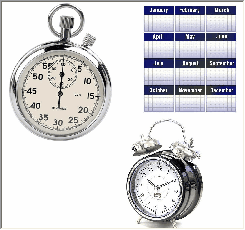Search Results for 'traders'
Trading Up from Mediocre to Great
 Can you imagine working hard for insignificant results? Or setting your standards so low that you need not put forth effort in order to attain your goals? Never, right?
Can you imagine working hard for insignificant results? Or setting your standards so low that you need not put forth effort in order to attain your goals? Never, right?
A competitive drive pushes many traders from the inside, causing them to take on risks others wouldn’t accept. They shun the security of a regular job, opting instead to speculate in an arena filled with financial danger but unlimited upside potential. Long hours are often recorded in an attempt to gain an edge. Tedious tasks like sifting through hundreds of charts nightly, religiously reviewing results, or poring over statistics of trades past are done with the sole purpose of improvement by traders who are hungry for success.
In other words, they want it.
Those kinds of things are what it takes to get better in trading, and many are willing to pay the price. Yet far too often – unfortunately – some traders settle for less.
I’ve encountered many of them. They say things like “I’m not really trading right now because I’m waiting for XYZ to bounce back and let me out of a pretty big paper loss I’m facing.”
What’s interesting is that the ‘paper loss’ they’re referring to is quite real. Even more noteworthy is what they fail to see, which is that other trades could put them back on the right track and actually get them turning a profit again – if they’d free up their account to allow themselves to actually take those trades. Sadly, they’re just unwilling to turn loose of a mistake, so they cling to hope and wait for a miracle.
Are you one of them?
Trading Up
Often times on the road, I’m looking for an opening in the left lane to get around that slow lady ahead of me who is too busy talking on the phone to go (at least) the speed limit. In the mall, I’m amazed at how many people walk aimlessly, without a clue, as if there’s no purpose or destination to move towards. Yes, I am a bit impatient, but the point I’m making here is that it’s a habit I’m in of continually looking for ways to improve my situation.
That’s particularly true in my trading. I don’t mind putting on risk, and I realize plenty of trades will fail. What’s most important to me is to monitor how those trades move and how the stocks are behaving.
Let me be clear… It’s unrealistic to think I can foresee the moves before they happen, but it’s not difficult to recognize price action that’s outside the recent norm. And that is the key.
Studying the price action closely allows you to identify when outlier moves begin to occur, and subsequently when an exit needs to be made.
Always Think In Terms of Gain
We just sold our house. The real estate market is still soft, and for about two months we had a lot of showings but no sale. The price was too high, and we had to come off the price a bit in order to sell the house. But we’re upsizing, so what we had to concede on the last house we more than made up in the new house.
Once I thought of a price reduction in those terms, it became a no-brainer. It was less personal. Understanding that giving up $1 here might mean I save $1.50 on the next home (because it’s larger and higher-priced), logic dictated that I think in terms of what I’d gain on the other side, not solely what I’d be giving up.
Why doesn’t everyone trade this way? Why not dump an average name for a better one – one that shows more promise, more potential? Why not put in the work to get to the next level and leave mediocre results in your rearview mirror?
Make it a habit to think this way, especially if you’re gunning for improvement. OR…be complacent and stagnate, because that’s the only other option.
What has helped you learn to dump losing trades in favor of new names with better potential? Share your thoughts in the comments…
Trade Like a Bandit!
Jeff White
Producer of The Bandit Broadcast
Are you following me on Twitter yet?
Uptrend Aside, Trading Scene Set to Improve
August seems so long ago, doesn’t it? Stocks had rebounded from their July lows, briefly, and had turned back down hard for a test. The test passed, as an important higher low was established.
From there, we all know the story of how the seasonally-weak September and October stood conventional wisdom on its head to post big gains. What’s not been spoken of much, however, is the way this 2-month rally has changed in recent weeks.
What began as a rip-roaring rise ripe with short-covering has evolved into a slower, more steady uptrend channel. The pace has cooled off a bit, while still continuing to make upward progress. In fact, new intraday highs were posted multiple times last week, despite the indecision we saw between the opening and closing bells each day. Today we’re seeing more of the same, as early strength has delivered new highs while modest profit-taking has caused the indexes to back down from their best levels.
To put it another way, the “dumb money” has had great success in recent weeks. Those who waited for strength to return before becoming confident enough to join in have been fortunate enough to chase extended markets and stocks and still profit. But for those of us who prefer to see some kind of rhythm associated with market moves, it’s been a one-way street without many ways to play the long side while still protecting the downside.
Astute traders have instead found it a bit more difficult to navigate the current environment, as anyone with an ounce of discipline has felt the uneasiness of adding long-sided exposure for overnights while simultaneously recognizing the limited opportunity of trading intraday. It has left many of us to do more scalping while waiting for more lively day-to-day price action and higher-quality bases to come along. Those bases often rely on some back-and-forth price action, which we simply haven’t seen of late.
Watch The Horizon
 Any trader worth his salt knows that conditions will shift. Maybe not immediately, but eventually.
Any trader worth his salt knows that conditions will shift. Maybe not immediately, but eventually.
That doesn’t mean prediction is necessary, because it isn’t, but it does mean staying alert.
When trading well, keep doing what works but be on the lookout for signs the setup may be changing. When trading poorly, it’s imperative to employ some other methods which are more suitable to the conditions. At the same time, hope can be had that a shake-up in the price action will bring more opportunities.
Right now, the market is in an interesting spot. The rally has brought the spring highs into play as we’re essentially testing them in this area. That’s a logical resistance area that could prompt some selling, depending upon the news flow. The uptrend channels seen in the averages could easily be penetrated to the downside, heightening concerns of whether that’s the end of the run. The other side of the coin is that the trend is still up, and no evidence has surfaced to suggest it’s changing.
So as a trader, here’s how I’m dealing with all this. The trend is up, so I’m favoring the long side while keeping timeframes short in order to offset the risk of walking the highwire here. I’m also mindful of potential shifts which could emerge anytime. We’re in the midst of earnings season, and that could easily sour the mood. We have the November elections tomorrow and the political implications of that, which is a major event. And then mid-week we have the FOMC, and with all eyes on the economy, the attention of traders will definitely be on Wednesday’s announcement and policy statement.
We could ramp from here and take out the spring highs before a pullback begins. It’s possible. We could break the uptrend channels and see some selling accelerate as traders recognize the trend line break and move quickly to lock in profits. Several scenarios are possible, and it’s important to keep an open mind here for that very reason.
I will say this: I’m expecting volatility to pick up sooner than later, and that means more opportunities for trading multiple timeframes. That’s where the real money is made, as you can have capital working for multi-day moves while still maneuvering to catch intraday moves for profits. Look alive out there, this is no time to get lulled to sleep.
Trade Like a Bandit!
Jeff White
Producer of The Bandit Broadcast
Are you following me on Twitter yet?
Narrow Your Scope With Basic Stock Filters
 Each night I work through literally hundreds of charts, aiming to find those setups with an edge. They’re the ones which allow me to not only clearly define my risks, but also offer potential profits which greatly outweigh those initial risks.
Each night I work through literally hundreds of charts, aiming to find those setups with an edge. They’re the ones which allow me to not only clearly define my risks, but also offer potential profits which greatly outweigh those initial risks.
I’m asked quite frequently by traders how I narrow down the universe of stocks to a more manageable list. The short answer is to start with price and volume filters in order to eliminate the low-dollar stocks, as well as those with poor liquidity. That alone will give you stocks to consider which aren’t as highly-speculative as penny stocks, as well as stocks which are liquid enough that there should be a buyer when you go to sell and a seller when you go to buy.
Beyond those basic filters though, you may still wish to narrow the list. In the charting program I use, dozens and dozens of additional filters are available. Among them are things such as Beta, Trade Range, Average True Range, Expanding Trade Range, Contracting Trade Range, and a lot more.
Just that brief list is enough to help locate stocks which move faster than the broad market, or to eliminate names which simply don’t move enough.
Base Filters on Broad Market Movement
 When dealing with ‘trade range’ types of filters, you can accomplish a lot. For example, you might generally use Average True Range to knock out stocks which don’t fluctuate much, helping you to eliminate the ultra-quiet stocks. When the market is starting to break out, look for Expanding Trade Range to help you locate stocks which are likely participating in the move or gaining momentum. When the market has made a big move already and is beginning to rest, use Contracting Trade Range to locate more stocks which are basing and may be starting to create patterns.
When dealing with ‘trade range’ types of filters, you can accomplish a lot. For example, you might generally use Average True Range to knock out stocks which don’t fluctuate much, helping you to eliminate the ultra-quiet stocks. When the market is starting to break out, look for Expanding Trade Range to help you locate stocks which are likely participating in the move or gaining momentum. When the market has made a big move already and is beginning to rest, use Contracting Trade Range to locate more stocks which are basing and may be starting to create patterns.
Don’t seek a one-size-fits-all filter, because it doesn’t exist. Keep an open mind, and put some thought into what it is you’re wanting to find. Stay flexible in your approach, and you’ll continually be able to avoid wasting time sifting through stocks which aren’t worth a second look.
The key to effective filtering is to learn over time how and when to vary the filter you’re using based on general market conditions. As you develop that skill, you’ll get really efficient at narrowing down the universe of stocks to a more manageable, appropriate list, depending upon whatever conditions you find yourself trading in.
Trade Like a Bandit!
Jeff White
Producer of The Bandit Broadcast
Are you following me on Twitter yet?
Stay Sharp
 A year ago, I was in a surgeon’s waiting room. He was running late after having to do an emergency appendectomy. He hadn’t overslept or blown off his appointments for a tee time – he was operating, just as I’d expect a surgeon to.
A year ago, I was in a surgeon’s waiting room. He was running late after having to do an emergency appendectomy. He hadn’t overslept or blown off his appointments for a tee time – he was operating, just as I’d expect a surgeon to.
With scheduled surgeries on the calendar, as well as the emergencies which inevitably pop up, he wakes up every day knowing he must be on his toes. He has to be prepared for whatever comes along. Routine procedures will even occasionally throw the proverbial curve ball his way, and he’s the one that must respond accordingly for the well being of his patients.
Some of you might be surgeons, but I’m confident that all of you reading this are traders. And at this point, hopefully you know exactly where I’m going with all this.
Maintain Your Edge
As a trader, it’s important that you stay active and stay sharp. You’ll of course take vacations (hopefully of the exotic type) and have times when life calls your attention elsewhere temporarily. That’s fine, and I’m certainly not suggesting putting your trading before all else – that would be unhealthy and out of balance. I’m all for maintaining perspective and priorities. However, if you truly want to get good and continually improve, you’ve got to be in the game on a regular basis to some extent.
I attended a couple of preseason NBA games this week. During the offseason, one player in particular had just signed a huge contract. Now, preseason games don’t mean anything at all. The fans love them, of course, but they’re generally treated like scrimmages and an opportunity for teams to start developing some chemistry after a few months apart.
Watching the game, it was quite clear who’s been working hard over the summer and who probably took the mindset of “it’s a long season, I’ll eventually get sharp.” The aforementioned big-contract player was of the former attitude. It was clear he worked on his (already great) game, and he was eager to get all the playing time he could – even in a preseason, so-called meaningless game.
This guy wants it, and he shows up to play every time out. In terms of dollars, he’s long since arrived and would have a hard time spending what he’s already amassed. But money is not his sole definition of success, and it’s clear in how he plays the game.
Plan & Play to Win
As you reflect on your trading, I wonder if you’re seeing some glaring problems standing in the way of your success. Some take more time to work out, such as learning to accept a loss or understanding the times when sizing up isn’t appropriate. But if it’s just more “minutes on the court” that you truly need, that’s a much easier goal to reach…and one which will pay many dividends.
The end of the year is approaching, but it isn’t here yet. You’ve still got a couple of months before you’ll need to review 2010 and look ahead to 2011 and set appropriate goals. That time will come.
For now, you still have time to make 2010 better. You still have time to gain some momentum into the end of the year, so that you can hit the ground running when January hits. But you’ve got to look at each day as an opportunity to grow.
Let me be clear though – it won’t happen from the sidelines. You’ve got to make it a habit to be in the market regularly. Modify your timeframes if you need to, and trade small when you’re struggling to get a feel for the tape, but be active, stay sharp and on your toes.
Surgeons operate, and get their hands (gloves) dirty. Athletes play and sweat and push for improvement. Traders trade and face the pressure and find ways to grow. The best simply do not allow themselves to go cold.
Earlier this year, I completed a major trader training project which required a lot of my time. It took a few months to finish it all. I could have cut that time at least in half, but I maintained a daily devotion to trading, even in the midst of a big undertaking.
I write blog posts like this one every week, and I produce a nightly stock newsletter for subscribers over at TheStockBandit.com. I’m a husband and a dad, and trading isn’t my entire world. But I’m in the market every day, moving my money into and out of opportunities as I see them. It’s the focus of my work day, and it’s what my evening preparation points to. Staying in the game is how I stay sharp.
Are you doing the same?
Trade Like a Bandit!
Jeff White
Producer of The Bandit Broadcast
Are you following me on Twitter yet?
Video Review of the Indexes 10-17-2010
The bulls posted another solid performance last week as more cash was exchanged for shares. That took the indexes to new recovery highs, but also brought some important resistance areas into play.
The big question on the minds of traders at this point is whether the pace will slow now that resistance from the spring has been reached. We’ll find out soon enough, but there’s still no signs of emerging weakness at this point.
As we head into a brand new week of trading, let’s examine some important levels to keep an eye on in the days ahead. That will have the greatest influence on how individual stocks are going to move, so it’s where the trading week begins.
Be sure to view in full-screen mode for best quality in the video.
Trade Like a Bandit!
Jeff White
Producer of The Bandit Broadcast
Are you following me on Twitter yet?
Trading vs Investing
 A recent email exchange with a new subscriber brought forth some important concepts I want to share here on the blog. Among this guy’s comments were the following:
A recent email exchange with a new subscriber brought forth some important concepts I want to share here on the blog. Among this guy’s comments were the following:
“I’ve decided to take more control of my money and future after investing for several years with a financial advisor. I’m sitting on a lot of cash..in setting up my portfolio should I scale in and out of some core positions in a separate account? Currently I feel as though I’m under invested, and it sucks to watch undisciplined investors make so much money. I guess the real question is, should I trade my entire account or should I trade some and invest some?”
During any nonstop rally like we’ve seen from the August lows, this is a natural reaction from a trader who has exercised good discipline. Sometimes it seems like it would pay better to just be ignorant and chase extended market moves like this one! Unfortunately though, that’s not an option for anyone who understands the two-sided coin known as risk.
Taking the ‘ignorance is bliss’ mentality may be great on the way up, as every gap higher and afternoon recovery adds to the bottom line. However, when the tide shifts and the tape gets painted red, it’s a recipe for feeling helpless and stupid for not exiting when the opportunity was there.
The Best of Both Worlds
I’m all for people taking control, because many financial advisors simply want to ‘outperform’ the market rather than make money – the only reason to have money in the market to begin with.
Here’s what I personally do with my money in order to benefit from both the short-term fluctuations and the longer-term trends which occasionally emerge…
I like to diversify my timeframes. I don’t trade Bandit setups with all my money, but I do direct all my money. By that I mean nobody else manages it for me. What I do is devote a chunk of it to my short-term trading. I want enough of it available there that no buying power issues arise, and so that I’ll have plenty of cash available to put on any trades I like.
I also take a chunk of money to devote to intermediate-term ideas, so these are plays which I like for the next few months but not short-term or long-term. I’m riding these out with smaller positions, wider stops, and I’ll often exit by way of shorting options against my common.
Finally, I leave money in long-term accounts (retirement accounts) where all I do is trade ETF’s for durations of 6-18 months. Those long-term plays are simply to have market exposure when I feel a big-picture trend is present which I want to be on board for, but do not want to react to every tick. For example, earlier this summer I was buying ETF’s for a bounce, and more recently I’ve been reducing exposure there (by selling to raise cash) and getting called out of those trades after selling calls against those positions.
So for me, dividing funds into different timeframes is really helpful. Also, I maintain separate accounts for these differing timeframes. That means I don’t login to my day trading account and each time see a 6-18month ETF play I’ve been in for 9 months and get tempted to exit after a 30-minute selloff. It is a little more to keep up with, but helps me avoid feeling like I have a lot of cash going unused.
Think of day trading with a stopwatch, swing trading with a clock, and position trading with a calendar. Each can be an effective way to watch the time, and they can all be used simultaneously.
If lately you’re feeling underinvested after this market run, you certainly aren’t alone. It’s a frustrating feeling, but there will be other trends to participate in, and one of these days you’ll be very glad to have cash on hand to put to work.
Any other thoughts?
Trade Like a Bandit!
Jeff White
Producer of The Bandit Broadcast
Are you following me on Twitter yet?
5 Rookie Trader Mistakes & How to Avoid Them
 In trading, as in life, lessons can be learned out of inspiration or desperation. It’s hard to say which is better, but I know that regret is quite a teacher.
In trading, as in life, lessons can be learned out of inspiration or desperation. It’s hard to say which is better, but I know that regret is quite a teacher.
For example, I’m in the process of buying a house right now, which will be the second for my wife and me. Eight years ago, I made several mistakes as a first-time buyer, some of which I’ve wished I could go back and change. Experience educates each of us, fortunately, and needless to say this time around (I think) I’m doing it right.
A lack of experience is responsible for many mistakes newer traders make as well. Those errors not only prove costly the first time around, but they can also ingrain some bad habits if not corrected quickly.
Over the years, I’ve been fortunate to work with hundreds of traders around the globe, of all trading styles and timeframes. And yet as diverse as these traders seem to be, a handful of common issues continue to surface. Coincidence? No. Just human nature, which the market preys upon.
So, to help you stay on the right path with your trading, let’s take a look at 5 common mistakes rookie (or struggling) traders make, and how to avoid them.
1. Adding to Losing Positions. This is a biggie, and it addresses perhaps the most common lapses in judgment among traders of all experience levels. Gartman says to “do more of what is working, and less of what isn’t working.” By definition, a losing position is not working. And unless you originally planned to scale into the trade, adding to a loss is a big no-no. Take note of your P&L, and if you’re wrong, avoid throwing good money after bad.
2. Forcing Trades Out of Boredom. Boredom is one of the biggest enemies of today’s trader, because it leads to so many bad decisions (like overtrading). Transaction costs are so low and it’s so easy to place trades that one can easily forget just how costly boredom trades can become. So if you’ve done your homework and come up with very little, place no pressure on yourself to be active. There are times where sitting tight is exactly what you should be doing, so have the courage and discipline to do nothing when that’s the case.
3. Switching Strategies By the Day. I’m all for trading with multiple strategies, and as your experience increases, your trading toolbelt will begin to fill. However, each of us during times of struggle has encountered the losing streak. That’s perhaps the biggest cause for traders to throw the proverbial spaghetti at a wall to see what sticks. While experimenting can yield some clarity, doing it in either the wrong fashion or too frequently can prove counterproductive. Get some trader training, put some strategies to work across multiple timeframes, and give them enough time to prove their effectiveness. Trying something for a day, losing money with it, and shifting quickly to something else isn’t responsible, so avoid that limited mindset.
4. Putting Everything on the Line for one ‘Idea’ Trade. I was once warned by a more-experienced trader, “don’t get any ideas!” He was right. A longer-term thesis takes time to play out, so leave that to the fundamentalists who don’t mind tying up their capital for months on end – for better or for worse. Stick with what the price action is telling you, and determine the best opportunities to get on board for the next move. Ideas are only useful when they relate to technical discoveries, so don’t bank on guessing right for one big recovery play – it may instead prove to be the final nail in the coffin.
5. Hoping a Stock Will Recover. Each of us has been trapped by a bad trade, and we’ve wondered if sitting motionless and simply hoping to be let out of the trap is the best solution. Marty Schwartz, of Pit Bull fame, mentioned how as a soldier, he was trained to do something when under attack…either fight back or retreat, but don’t just sit there. Hope truly is a 4-letter word in the trading realm, and relying solely on hope will provide plenty of damage to your trading account. Stops are available for good reason. Game plans offer if/then scenarios to follow under the gun so that big decisions need not be made in times of stress or volatility.
Avoid making these mistakes, and your money will be much harder for the pro’s to take.
Trade Like a Bandit!
Jeff White
Producer of The Bandit Broadcast
Are you following me on Twitter yet?





